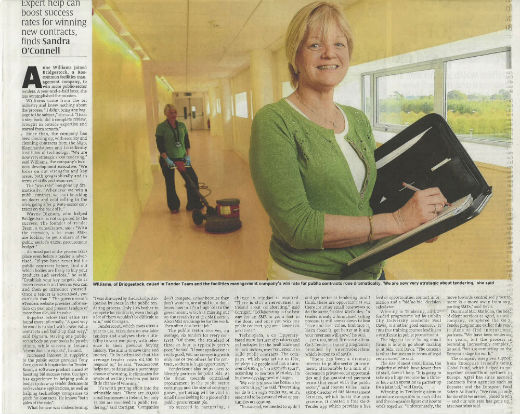
The importance of the Bid Library, comprising, prior responses tagged by industry and solution. Company information in an organised structure

The importance of the Bid Library, comprising, prior responses tagged by industry and solution. Company information in an organised structure

Our two expert procurement managers, Gavan and Eoin, have over 50 years’ of experience between them. Their views on tenders are consistent with many other buyers: tenders are becoming ever more crucial, early engagement with the client is increasingly important, and buyers are increasingly frustrated by the quality of proposals they receive. Early engagement allows you to understand what value you need to offer to the client in order to win the business. As Gavan says, ‘You are delivering true value in your tender when the client trusts that you will deliver greater benefit than your competitors and can clearly articulate what that benefit will be’. However, cutting costs and reducing your price is not always providing extra value. However, cutting costs has a finite impact, as you can’t cut costs forever. If a client has two equally good tenders under consideration, one of which drives revenue and one of which reduces cost, the one that drives revenue is usually the better decision. You tender should have a range of value touch-points, tailored towards the client and the evaluation team, and each evaluation team member, eg. End user, legal, financial, human resources, etc. Look at the award criteria, and what elements of value can be portrayed. Use proof points to embed the value within the tender document. At TenderTeam, we provide value through the benefits that come from helping you to develop better tenders more efficiently that win more business. We can help you create your value proposition, see www.tenderteam.ie

The quality of tenders is generally getting better and better. In a boom economy companies tend to spend more on their tenders, as there are more contracts available to win, as organisations as spending more money on capital and operational projects. Make hay while the sun shines. When an economy turns, tender competition is sometimes even tougher, as lucrative contracts become even more valuable to see out the recession and hopefully can lead to some years of stability. The difference is that some firms can still win in good and bad times by spending a lot less on their tender process, and being a lot more successful. We’ve seen these smart companies do very well. How do they do it? Our clients have used our TenderSmart methodology of tendering. This is a benchmark for how much you should be spending on your tenders, and how you can manage this with the best chance of success. We look at your ratio of tender specialists to salespeople, the amount of tenders you complete and win each year, what sector you are in and the growth of your sector and competitors in that sector. Then we look at your positioning, the quality of your tenders and what type of pipeline of opportunities you can expect. We then implement a TenderSmart programme, which is guaranteed to increase your success rate over the year. If it doesn’t – you get money back and we get a bad reference – and this has never happened to us in 10 years. To enquire about our TenderSmart programme, see www.tenderteam.ie

Tender Team’s Eoin Lonergan is delighted to be a guest speaker at the upcoming Whitepaper conference ‘Awarding Public Contracts Skilfully and Lawfully within the Procurement Rules’ on 28th September 2022 in Dublin.
For tickets please visit: https://whitepaper.co.uk/conferences/procdub22
These will answer questions such as:
Awarding public contracts skilfully and lawfully within the procurement rules
How do you rescue the situation if the value of the contract reaches and exceeds the thresholds and you need to vary?
How do you incorporate carbon and climate metrics into tender documents, that ensure fairness and equity across bidders?
Where are the limits to transparency and full disclosure from the outset, including possible breaches of confidence and prejudicing retenders?
What mechanisms can mitigate the risk of rising costs and fluctuating prices, including energy and stakeholder concerns about going to market?
What are the differences, risks and advantages of the Competitive Flexible Procedure?
How do you decide if a tender is abnormally low, and what do you do if it is, supported by practical examples of borderline cases?
How do you control – and overcome – the problems with early contractor involvement, e.g. pre-market testing or specification writing, so you reap the benefits without conferring an advantage?

Date: 24th, September 2010 Author: Wayne Dignam
Over the years, the lives of many people have changed dramatically as a result of 12- Step Programs like that which form the foundation of Alcoholics Anonymous.
The success of these programs led me to look up the steps to see if they—or some variation of them—could be applied to breaking the addiction to bad habits that some fledgling proposal companies have.
At their core, 12-Step Programs seek to represent the human experience in three dimensions: physical, mental, and spiritual. For purposes of this article, we will replace the spiritual dimension with a dimension that we will call “professional,” referring to our growth as professionals in proposal development.
Before going further, let me be clear about one thing: this article is not intended to make light of the 12 Steps. So let us look at 12 Steps for living with the proposal development profession.
Accept your inability to control every aspect of the proposal development process. Every opportunity has factors that are well beyond the control of the proposal manager or contributors. First, our potential customers sometimes delay RFPs or deliver them early with surprises embedded in them (“Hey, that requirement was not in the Draft RFP!”). Sometimes, the delays and surprises work for you, but often they work against you.
Internal issues arise during every proposal effort. For example, a key Subject Matter Expert (SME) may be out of the country, a server may go down unexpectedly, or maybe you have conflicting information from two or more sources. Then there is my favourite: a senior manager decides that his/her review is essential even as you are packing the proposal into boxes to go to the customer. The point is that living the proposal life can be like riding an angry bull: you never know which way you will be jerked next. Admitting that you are powerless moves you one step closer towards sanity and serenity.
Once you accept that you are powerless, you need to believe that a higher power can help you. That “higher power” could be Tender Team. Maybe you would prefer to hang your hat on the processes purported by a consultant with a proven track record. The point is to believe that there is a better way and that following that path will lead to sanity.
No one is advocating the burning of incense while chanting in a dark corner of your office, but you do need to let go and “Feel the Force.” Relying on something bigger than yourself is a positive step, not an admission of personal inadequacy or failure. Think of this step as making a decision to implement a methodology that has been proven time after time by other people. Since every business is different, you can fine-tune specific practices to suit the needs of your organization, but make a firm commitment to the process you decide on.
Being fearless is key to improvement. You may have to give up some portions of the process that do not work, but with which you are comfortable. Be brave and dig deep. Do you really have a good way to analyze an RFP, or are you simply parsing pieces to give to authors? Do you really need to print in-house, or are you being a control freak? Question everything.
If you think you have process problems, do not sweep that fact under the rug. Come to terms with the causes of the problems, and take pride in being able to deal with them in a positive manner. People will respect and admire you for having the forthrightness to admit errors and come up with solutions.
Get out of your comfort zone, and be ruthless regarding defects in your process. If one way is not working, try another. Complacency leads to repeated failure, and that means you will lose business repeatedly. By embracing the idea that defects cannot be allowed to stand, you will be empowered to take big steps toward winning more business.
Best-selling author and lecturer Tom Peters once said: “If it ain’t broke, break it!” Every process can be improved if you poke at it long enough and find the fractures. Nearly two decades ago, many of us embraced a program called Total Quality Management (TQM) to identify ways of improving processes on a continuous basis. We actually looked for ways to cause a process failure so we could eliminate the failure point. While you rarely hear of TQM these days, it had some very good aspects to it. They are very similar to what we now see at the heart of newer models, including the BDCMM. Make it a part of your routine to continuously review your processes to see if they can be broken.
It is easy to rationalize losses: “We did not have enough time,” “Engineering was too busy to contribute much to the proposal,” and so on. But if you do an honest assessment of why you lost, you may find something that can be done differently the next time to improve the outcome. Simply trying harder while expecting a different result is, as they say, the definition of insanity.
Look at what must be changed, and get on with it! Do not be satisfied with watered-down changes. Be bold! Be decisive! Of course, changes need to be realistic to be effective. In other words, you do not want to put procedures in place that will overextend the capabilities of your organization or complicate your life unnecessarily.
The need for continuous improvement is ever present. What works today on one proposal may not work tomorrow on a different proposal. A consultant’s ideas may have been good 15 years ago, but out of touch with today’s business development environment. Be relentless in your pursuit of perfection, but realistic enough to know that you will never achieve it. When you try something that does not work, admit it to yourself and those around you so everyone can benefit from the error. Remember, it is a sign of strength—not weakness—to admit the error of your ways.
Attend conferences, read trade publications, attend related seminars. If you do not expose yourself to new ideas, you will not know if there are better ways to do things. Thirty years ago, nearly every proposal written by any organization began with “[ABC Company] is pleased to present this proposal in response to RFP number… As the leader in [Widget Technology], we feel we are in the best position to provide…,” ad infinitum, ad nauseam. Today, no proposal specialist with an ounce of respect for the profession would let that stand. Indeed, we have learned to shift the focus from how great we are to what the customer really wants, and we teach this to every newbie in our trade. But how did we figure it out?
When you reach this final step, it is time to become an “evangelist” for best practices. When you find something that works well, share it with your co-workers and other proposal professionals, even if they are outside of your company. The more we share, the better our proposals will be, and the easier it will be to prepare them.

Click here to download the full article
Defeated England World Cup bid leader Andy Anson recently admitted that there is no point in the country bidding again until FIFA reforms its structure, and said:
‘When you have the best technical bid, fantastic inspection visits, the best economic report, and, from what people told us, the best presentation, it’s quite hard to stomach that all that seemed to count for absolutely nothing.’
England winning the bid would have been great for Ireland too, so we should also be disappointed for the English bid team. This comment from the bid leader is very similar to comments I hear from some companies in the public procurement market. ‘The process of procurement is flawed and badly needs improvement!’ This applies to both buyers and suppliers and the culture in Ireland does need improvement.
Tender Team assists in the preparation of tenders for the suppliers of goods and services to the public sector market in Ireland and abroad. We also help buyers prepare a proper request for tender (RFT) in defining exactly what they are looking for and what type of criteria are important in evaluating suppliers. This covers a tender submission for the provision of legal services, to public relations services, to the construction of a school, to the provision of care services for the HSE. We live and breathe tenders! So what is our experience of the public sector procurement process? There are some companies that produce excellent tenders and have very high win rates. There are some suppliers that have low competency in producing tenders and look at every excuse as to why they are unsuccessful, forgetting about their own tender management capabilities. Likewise, there are some buyers who devise concise Requests for Tenders (RFT) with very clear marking schemes and evaluation criteria and who have a very clear sense of what they are buying and what type of company they want. There are also some buyers who haven’t a clue as to what they want and how to ask for it in the RFT.
In 2010 I witnessed some bad practices from both suppliers and buyers, for buyers these include:
Here’s a horror story a construction company came to me with recently:
In a request for tender for the construction of a school, the contractor was asked to provide CVs of personnel proposed, upon being awarded the contract. The question stated that this information was required ‘on request’. Nowhere in the tender document did it state that the contractor had to respond to this particular piece of information or provide any CVs of personnel – only if he was asked on request. However, the contractor was disqualified because he did not state that he could provide this information upon being requested.
Is the contracting authority (buyer) right or is the supplier (contractor) right? Public procurement is highly regulated, so refer to SI 329, SI 130, EU Directive 2004/18/EC, Circular 10/10…etc, etc. Did you find the answer? The answer is that the public procurement process should be fair, transparent, treat companies equally and be proportionate to the requirements of the contract, but often times situations like this arise. The contractor is afraid to burn bridges and the buyer awards a contract ineffectively so how does the public sector process improve? How is the public assured that the best value for money was gained by the buyer who is spending our hard earned taxes? Indeed, where is the accountability for the procurement of goods and services? The short answer is that there is none at present. We need a procurement Ombudsman who can audit buyers, contract awards, and hear from disgruntled suppliers to make recommendations for improvement.
However, it’s not just the buyers that are prone to making mistakes, I have seen suppliers making many mistakes in the procurement process:
Public Procurement has become a hot topic in many industry sectors in Ireland in the past two years. Due to the difficult economic climate, companies are investing more time and money in their tender documentation to win business to survive. Public sector work appears very attractive as a way to retain staff, gain public sector experience, maintain turnover levels, maintain cash flow, to survive. There is guaranteed payment, now that we know that the State’s expenditure is funded for the next three years!
The State has to look for cost savings across all departments, and The Department of Finance is encouraging Contracting Authorities to look for better value for money in the marketplace. In August 2010 it issued a Circular to all buyers with a list of instructions to facilitate Small to Medium Enterprise (SME) participation in public procurement. With tighter budgets, Contracting Authorities are tendering more projects to more companies to save money and get a better service for their requirements. Whereas in the past a legal contract would have been awarded to one company for a five year period, now legal contracts may be divided into lots and awarded to a panel of legal companies over a two year period. So there is more opportunity for suppliers to win contracts in the public sector.
Back to our unfortunate English colleagues, perhaps in their next bid they’ll make sure to keep the tabloid newspapers from investigating bribery in FIFA and then they may have a better chance of winning. By that stage, Prince William will then be King William, and could FIFA possibly refuse a King? Now that’s a winning tender strategy!
Wayne Dignam BA BAI MEngSc MBS MIEI is a Bid Director with Tender Team, Ireland’s leading bids and business development consultancy. Contact Wayne at 01-6797170


Expert help can boost success rates for winning new contracts writes Sandra O’Connell
Anne Williams joined Bridgestock, a Roscommon Facilities management company, to win more public-sector tenders. A year and a half later, she accomplished the mission.
Williams came from the oil industry and knew nothing about the process. “I didn’t bring any baggage to the subject,” she said. “I took a step back, did a complete review, brought in outside expertise and started from scratch”.
Since then, the company has been cleaning up, with security and cleaning contracts from the Sligo, Blanchardstown and Letterkenny Institutes of Technology. “We are now very strategic about tendering,” said Williams, the company’s business development executive. “We focus on our strengths and key areas, both geographically and in terms of skills and resources.”
The “win rate” has gone up dramatically. “Whenever we win a public contract, we start knocking on doors and cold calling in the area, going after private sector contracts on the back of it”
Wayne Dignam, who helped Bridgestock is not surprised by the success. The founder of Tender Team, a consultancy, said: “With the recession, a lot more SMEs are looking to get a share of the public’s sector €12bn procurement budget”
A crucial part of the process takes place even before a tender is advertised. “If you have never bid for public contracts before, find out which bodies are likely to buy your products and services,” he said. “Establish your key targets, do as much research on them as you can and then go introduce yourself. Once a tender is advertised, you can’t do that.” The government’s eTenders website provides information on past and present tenders of more than €25,000 in value.
Supplies below that value are found more informally. “A good way forward is to start with lower-value contracts and build up that way,” said Dignam. Having one public sector body on your books helps win others, while success in Ireland “opens doors to exports,” he said.
Extract from The Sunday Times
20th October 2013
Find out more about our tendering process.

How can Tender Team help you when it comes to tendering for new work? There are lots of ways we can help, but to make life easy we have packaged our services into five simple steps to tender success.
Would you like to learn more about tendering? We often run public training courses that are CPD approved. Attending one of our training courses could help you understand an area of tendering better, or increase your confidence in presenting your company to potential clients. We also provide in-house tender training tailored to your needs; whether it is coaching the presentation team, or understanding the red tape of pre-qualifying.
How successful is your company in winning work? Do you win one in five tenders for example? Could you improve your company’s win rates? We can analyse your previous tenders and determine where you can increase your marks for quality, discuss pricing with you, and help you understand what public sector buyers really want from you as a supplier.
How good are your in-house systems for dealing with the short deadlines attached to a tender? Do you find yourself scrambling once a tender is published? Do you make a Go/Stop decision? We can provide you with an in-house system review and help you put procedures in place to make the tendering process more streamlined and efficient and ultimately saving you money.
Are multiple promising tenders published at the same time? Do you struggle to manage the process for more than one tender and fail to meet deadlines? Tender Team can provide you with a bid manager to work with you and your team. We can hold kick-off meetings and manage the entire tender process from gaining the necessary inputs to supporting design thus ensuring a competitive tender is achieved by the deadline.
Do you tender infrequently? Do you find it difficult to have the right resources available once a tender is published? Getting up to speed on what is required to tender, and how to structure your response can be time consuming and daunting. Tender Team can provide the skilled support that you need without the daily overhead of a full time in-house bid manager. We can help you to maximize your company’s capacity while also optimising efficiencies.
What level of service does your company need? Check out our new streamlined processes for more information.

Written by Erica Lund, Tender Consultant, Tender Team, [email protected]
I recently had a client who worked with an organisation for seven years and then found herself having to tender for the work this year. A change in procurement rules within the organisation meant that open public tendering was their only option.
In this particular case, not tendering was not the answer, but she sought the professional help of Tender Team and thankfully won the tender. You might think of course that she had to tender for the work, how else is she going to win new work and keep the company in business? But sometimes the situation companies find themselves in is not so clear cut.
Do you know your client? Have you worked with them in the past? More importantly do they know you? And do you think your company’s reputation stands up to scrutiny?
With the downturn in our economy I have seen many companies tendering for everything that is openly published even if their chances of winning the tender are less than 5%.
It’s like the lottery, if you’re not in you can’t win! But ask yourself; is tendering for everything the right path to winning new work? It will certainly keep staff in the office busy, but are you getting the right return on your investment?
Taking the time to think strategically when it comes to tendering for publically procured work can pay dividends.
Developing a procedure where you can quickly assess each tender that is published and determine your chances of winning can really separate the wood from the trees.
This procedure is often called a Go/Stop decision. It takes account of a wide variety of factors which will influence the final outcome for you and your company such as:
Having this decision made at the start of the tendering process can reduce the number of tenders your company submits and at the same time increase your chances of winning the tenders that you do submit.
You can concentrate your resources on those tenders that you have a better percentage chance of winning from the outset. Sometimes NOT tendering is actually the right answer.
For a free Go/Stop decision support tool and more information on Go/Stop decisions that save you time and money, please contact Erica at [email protected].
Ahead of our seminars in September and October, we’ve compiled some quick tips to help you win business with your bids and presentations.
If your tender deadline is fast approaching, get in touch and we can help!